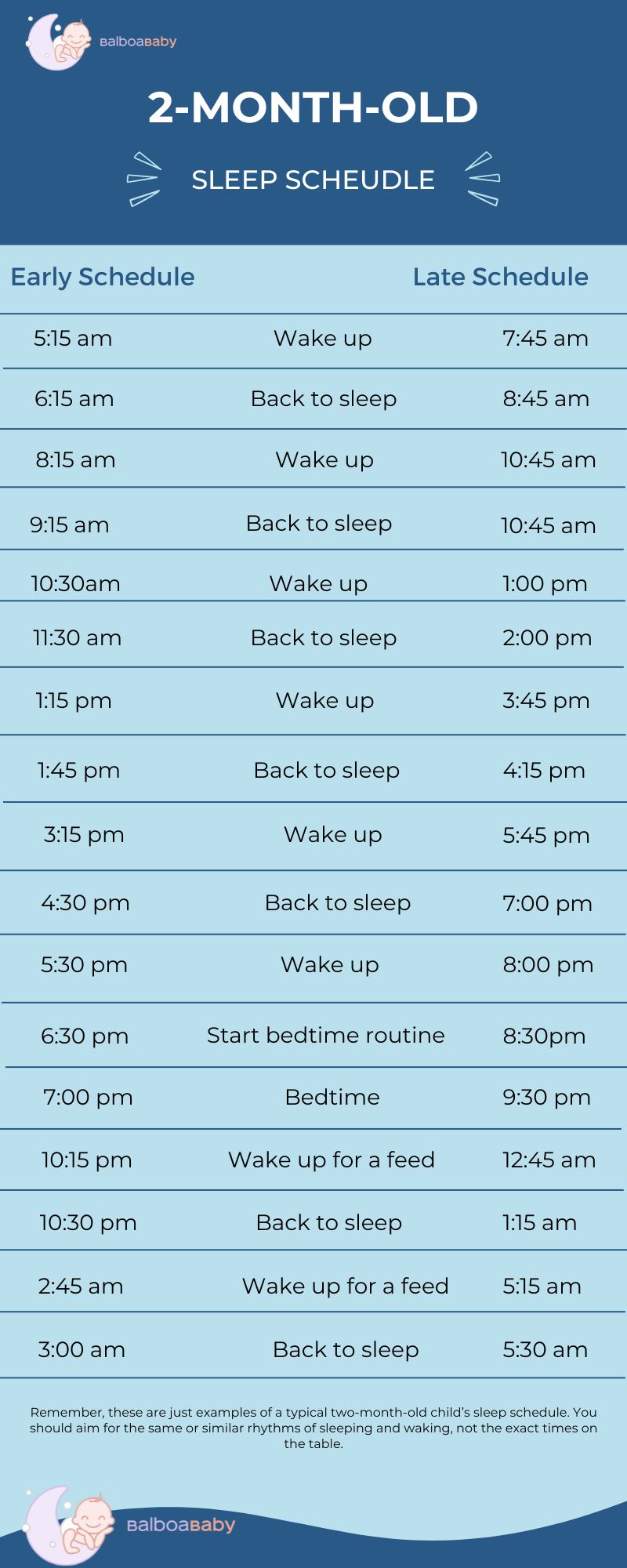Now that your baby is two months old, you might be thinking about daily routines and how to get your little on a sleep schedule. However, although you may start to notice your baby has a preference for sleeping or waking at certain times, they are not yet ready for a sleep schedule.
What you can do at this stage is to lay the groundwork for a successful sleep routine in the months to come. Let’s take a look at what sleep looks like for the average two-month-old baby and how to set yourself up for success in the months to come.
How Much Does a Two-Month-Old Baby Sleep?
Once you’ve passed the eight-week mark, you can expect your child to sleep between 14 and 17 hours every 24 hours. At the end of the second month, your little one may have more extended periods of sleep at night and more of an “awake with plenty of naps” kind of rhythm during the day.
This rhythm usually consists of one to one-and-a-half hours of awake time followed by half an hour to two hours of nap time.
Can a 2-Month-Old Baby Sleep Through the Night?
When a parent of an older baby asks if they can sleep through the night, I usually begin an answer with, “It depends on what you consider through the night.” However, no matter how you define it, a two-month-old baby is not yet ready to sleep through the night.
While your baby may show signs of developing a slightly more extended period of sleep during the night, it is still normal for them to wake for a feed every few hours.
What is a Good Sleep Schedule for a 2-Month-Old Baby?
The best sleep schedule is always the one that works for you, your baby, and other caregivers and family members.
If you are an early riser and prefer to have your little one settled for the night at 7 p.m., then go for it. On the other hand, if your family keeps going well into the night, there’s nothing wrong with your two-month-old having a 9 p.m. or even 10 p.m. bedtime, as long as they get up at a suitably late time the following day.

Remember, these are just examples of a typical two-month-old child’s sleep schedule. You should aim for the same or similar rhythms of sleeping and waking, not the exact times on the table.
Wake Windows for a 2-Month-Old Baby
Before we talk about the wake windows of a 2-month-old child, let’s make sure we clearly define what a Wake Window is.
What is A Wake Window?
A wake window is simply the amount of time a child is awake between periods of sleep. These wake windows, their length, when they occur during the day, and how they change over time are relatively similar for most babies.
Understanding how long wake windows are and where they usually land during a 24-hour period will help you identify your child’s natural wake windows and build a successful sleep schedule.
Your 2-Month-Old Wake Windows
At the eight-week mark, your child will have wake windows of roughly one hour. After these 60 minutes are up, they’ll be ready to sleep again. However, during this month, those windows begin to lengthen so that by the time you hit 12 weeks, your little one will need about 90 minutes of awake time before they can go back to sleep.
How to Get a 2 -Month-Old Baby to Sleep Through the Night
A two-month-old baby is too young for formal sleep training and isn’t yet capable of sleeping through the night every night. Instead of trying to get them to sleep through the night, concentrate on good sleep habits and routines.
2-Month-Old Sleep Problems
These are the most common sleep problems for a two-month-old child and out tried and tested solutions.
Problem: Difficulty Settling Down for the Night
If your little one seems to be exceptionally resistant to settling down for the night, it could be that they are:
- Overtired: Although this seems counterintuitive when a child is overtired, they have much more trouble falling and staying asleep. This often happens when a parent tries to keep their little one awake in the hope of having them sleep at night. Unfortunately, this technique almost always backfires.
- Napping too late in the day: An especially late or long afternoon or evening nap can leave your child refreshed and unable to fall asleep at bedtime.
Having trouble distinguishing between night and day: Babies aren’t born with a functioning internal clock. Instead, they learn about night and day and develop a 24-hour rhythm sleep-wake cycle.
Solution #1:
During the day, make sure you put your baby down for a nap as soon as they start showing signs of tiredness.
These sleep cues may be
Staring off into the distance
Flushed eyebrows
Avoiding eye contact
Yawning
Eye rubbing
Being “fussy”
If your child gets to the stage where they are crying, stiffening their body, or struggling away from you, they are over tired.
If your little one is showing signs of tiredness and it is less than an hour to bedtime, consider starting your bedtime routine early and taking it incredibly slowly. Make bath time longer, have a couple of stories, and then lay them down a little early.
Don’t try to keep them up until exact bedtime, as you may miss your opportunity to have them fall asleep.
Solution #2:
Just to make things especially difficult, to avoid overtiredness, you may leave your baby to sleep later in the day or for longer and this, in turn, leaves them recharged and refreshed for the evening.
Avoid starting a nap any less than two hours before bedtime; if your child is still asleep two hours before bedtime, start making noise and see if they wake up. If your child does sleep later than usual, consider starting your bedtime routine later. This will make things easier and more restful than settling a wide-awake baby down for a sleep.
Solution #3:
Ensure your child’s daytime is full of light, sound, and interest. Play, go for walks, sing, and have fun! Then, at night, ensure none of those fun activities happen and that all light is subdued. This will make it easier for your child to get the message that “this is the time when we all go to sleep.”
Problem: Multiple Night-Time Feedings
It’s unusual for a baby of this age to feed once or twice during the night, but they do not need to be feeding three, four, or even more times between, for example, 10 p.m. and 6 a.m.
Solution #1: Increase Day-Time Feeds:
Encourage your baby to eat more during the day. This may be enough to cut down on the severe overnight munchies.
Solution #2: Try a Dream Feed
Before you are ready to settle down for the night, try giving your baby a top-up feed. While they are still asleep, go in. lift them out of the crib and offer them a meal. Many babies will start feeding without waking properly, and this late-night snack can tide them over for up to six hours, giving you a decent chunk of sleep.
2-Month-Old Top Sleep Tips

Here are some of my top sleep tips to make creating and maintaining a 2-month-old sleep schedule as simple as possible:
Define Night and Day
To help your baby learn that daytime is for waking and night-time is for sleeping, make the difference between the two very obvious. For example, during the day, have lots of play, fun, noise, and light while your little one is awake. Then, at night, have feeds and changes without play, only low, gentle speech, and use subdued lighting.
Avoid Negative Sleep Associations
When we talk about negative sleep associations, we mean all of the things your child needs, from other people, to help them fall asleep. These are things like:
Being walked up and down.
Rocking in a chair.
Songs and lullabies.
Feeding to sleep.
All of these things are pleasurable for your baby, but prevent them from learning how to self-soothe so they can fall asleep on without help.
At this stage, try laying your baby down to sleep while they are sleepy but still awake. Then, avoid rushing to pick them up if they fuss a little. Your child may just surprise you by dozing off without needing to be rocked or cuddled.
Establish a Bedtime Routine
If you haven’t done so already, now is the perfect time to establish a bedtime routine. This kind of predictable, step-by-step pattern will give your baby clear signals that it is time to wind down and go to sleep.
A typical routine might include a warm bath with minimal play, a change into bedclothes, a feed, a story, a cuddle, and then a lay down in the crib.
Start the routine at about the same time every evening, roughly 45 minutes before you want your baby to lie down and go to sleep.
Look for Sleepy Cues
By two months; you may have begun to notice your child get sleepy at a similar time each evening. If you do, try to sync your bedtime routine with these sleepy cues. This will maximize your chances of success.
- Sleep Schedule for a 2-Month-Old Baby - December 24, 2022
- Sleep Schedules for Your 18-month-old Toddler - December 23, 2022
- Sleep Schedule for a 6-Month-Old Baby - December 11, 2022







